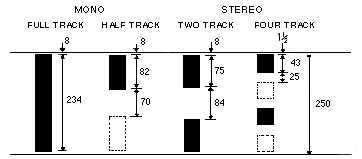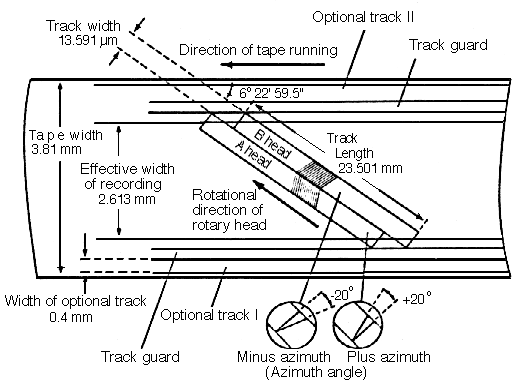The most commonly used medium for recording sound. It is manufactured in various widths (1/4, 1/2 and one inch primarily) and thicknesses (3.0, 1.5, 1 and .5 mil where 1 mil = 1/1000 inch) for different purposes, which now include video and digital recording.
The tape is coated with an oxide EMULSION, which when exposed to the variations of the magnetic field at the recording head of a TAPE RECORDER, is arranged in similar variations, each particle of the emulsion having its own magnetic field, the direction and intensity of which indicates the SIGNAL's AMPLITUDE and FREQUENCY. See diagrams under EMULSION.
The most common backings used for tape are polyester and mylar (which stretch when subjected to a strong pulling force) and acetate (which breaks when pulled). Uncoated tape used to separate other sections of tape is called leader.
Magnetic tape superseded the earlier MAGNETIC WIRE recorders after World War II because of the ease with which one could SPLICE and therefore edit the tape.
See: TAPE LOOP, TAPE MUSIC, TAPE RECORDING.
The standard speeds at which analog tape recorders play the tape are 30, 15, 7-1/2 inches/sec (ips) in professional use (76, 38, 19 cm/sec respectively), and 7-1/2, 3-3/4 and 1-7/8 ips (19, 9.5, 4.75 cm/sec respectively) in normal home use. One, two, four or more CHANNELs or tracks of information can be stored on tape, the principal configurations of which are shown in the following diagram.
For some hazards of tape usage, see CROSSTALK, DROPOUT, FLUTTER, HISS, PRINT-THROUGH, WOW. See also: BULK ERASER, CUE, DEGAUSS, DUBBING, DYNAMIC RANGE, SEPARATION, TEMPOPHONE.

Standard tape recording formats for 1/4-inch analog tape as used by the Ampex Corporation. Dimensions listed are in mils.
DIGITAL RECORDING also uses magnetic tape as a storage medium, such as digital audio tape (DAT), but these smaller formats cannot be spliced. The tape speed for the DAT format is only 8.15 mm/sec because the tape head itself rotates at 2000 rpm in order to achieve its high bandwidth. When this format is referred to as RDAT, the R stands for 'rotary head'.

The structure of digital audio tape (DAT) and its head configuration..
home